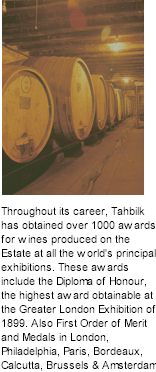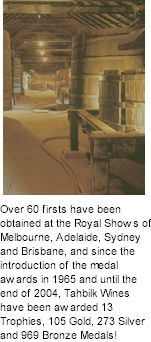About Tahbilk - the Winery
Tahbilk
Established 1860, Tahbilk is one of Australia's most scenic and historic wineries
Located in the Nagambie Lakes region of central Victoria (120kms north of Melbourne), one of the nation's premium viticultural areas, the property comprises some 1,214 hectares of rich river flats with a frontage of 11 kms to the Goulburn River and 8 kms of permanent backwaters & creeks. The vineyard comprises 168 hectares of vines which include the rare Rhone whites of Marsanne, Viognier & Roussanne, along with classical varieties such as Shiraz, Cabernet Sauvignon, Merlot, Cabernet Franc, Malbec, Chardonnay, Riesling, Semillon, Sauvignon Blanc & Verdelho.

Harvest commences in early March and continues for five to six weeks with approximately 1,600 tonnes of grapes processed. Total production is over 100,000 cases with just over 20% being exported to the key markets of U.S.A., United Kingdom, Canada, New Zealand, Switzerland and the Scandinavian countries.
In 1860, the same year that Phylloxera was first observed in France, Melbourne businessmen, including John Pinney Bear, formed a company to create a vineyard on the Goulburn River, with the grand aim of planting a million vines, an achievement yet to be realised with some 360,000 vines currently planted! The site chosen was referred to by Aboriginals as tabilk-tabilk meaning the place of many waterholes.
The next major development came in 1875 with the construction of a New Cellar, running at right angles to the 1860 Cellar
Excavated in just 12 weeks by James Purbrick (a third cousin to Reginald who was to purchase Tahbilk some 50 years later), 20,000 cubic yards of soil was removed by horse drawn carts (one of which is on display in the original cart-sheds opposite Cellar Door). The walls and arch of the New Cellar are 3 feet thick with the arch being self-supporting (using no keystone) and then covered with earth. The bricks are interlocked as only sand and lime were used to join them together with the whole cellar completed in time for the 1876 vintage.

The Swiss-French impact then continued with Francois Coueslant, considered in his day to be a most knowledgeable vigneron and progressive farm-manager, taking on the General Managers role from 1877 -1888. He was responsible for, amongst many innovations, the construction of the distinctive Tower (1882) that surmounts the original Winery building and features on current Tahbilk labels.
The Tower's first level played a functional role in winemaking until the 1940's. The second level was used as a storeroom for oats for the horses, with the third level described by Coueslant as "an observation room, from which you will be able to have an eye over all the vineyard, which fact may help the work a little". The upper level was purely aesthetic.
The appearance of Phylloxera in the Tahbilk vineyard in the late 1800's led to a decline in the winery's operations
The advent of Phylloxera, a vine louse that attacks the roots of grape vines and which decimated the European vineyards & Victoria's burgeoning Wine industry of the day, coupled with the death of John Pinney Bear and departure of Coueslant, lead to a period of decline in the fortunes of Tahbilk. In 1925 Reginald Purbrick, entrepreneur and later Member of the British House of Commons, purchased the property from the Bear family with the idea of rooting out all vines and subdividing it into dairy farms. Finally persuaded that the winery was viable he offered it to his son Eric, then a law and history student at Cambridge University, who took over management and winemaking responsibilities in 1931.
Faced with the dual problems of the Great Depression and lack of public interest in table wine, as well as his own viticultural inexperience, Eric succeeded in becoming an innovator in the wine industry and was the first to market bottled wine under its varietal name in Australia. Eric was joined by his son John in 1955, and John's son Alister - a graduate of the Winemaking Course at Roseworthy College, took over the role as winemaker and General Manager in 1978 and continues to this day.
